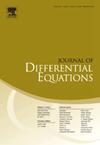与不变直线相切的环附近的异斜分岔
IF 2.3
2区 数学
Q1 MATHEMATICS
引用次数: 0
摘要
在本文中,我们提出了一种检验近哈密顿系统中与不变线相切环附近的异斜分岔的方法。我们的目标是推导广义Melnikov函数的渐近展开式,它不仅包括一阶Melnikov函数,而且包括更大范围可逆哈密顿系统中的高阶Melnikov函数。我们将我们的发现应用于具有n次多项式扰动的三次可逆哈密顿系统。我们的贡献包括:(i)利用任意n次多项式扰动的一阶Melnikov函数确定切环附近极限环的精确数目。(ii)在三次扰动(n=3)下,用简化表达式和可积条件导出系统的全阶Melnikov函数。我们的分析表明,一阶、二阶、三阶和四阶Melnikov函数在环附近分别导致三个、五个、六个极限环和一个极限环的分叉。(三)应用改进的切比雪夫准则和元素组合技术确定三次扰动一阶Melnikov函数的最大零数的确切上界。本文章由计算机程序翻译,如有差异,请以英文原文为准。
Heteroclinic bifurcation near a loop tangent to an invariant line
In this paper, we propose a method for examining the heteroclinic bifurcation near a loop tangent to an invariant line in near-Hamiltonian systems. Our objective is to derive the asymptotic expansion of a generalized Melnikov function, which encompasses not only the first-order Melnikov function but also higher-order Melnikov functions in a wider range of reversible Hamiltonian systems. We apply our findings to a cubic reversible Hamiltonian system with polynomial perturbations of degree n. Our contributions include:
(i) Determining the precise number of limit cycles near the tangent loop by using the first-order Melnikov function for polynomial perturbations of arbitrary degree n.
(ii) Deriving all-order Melnikov functions with simplified expressions and integrable conditions for the system under the cubic perturbation (). Our analysis reveals that the first, second, third, and fourth-order Melnikov functions lead to the bifurcation of , , six limit cycles, and one limit cycle near the loop, respectively.
(iii) Determining the exact upper bound on the maximum number of zeros of the first-order Melnikov function for the cubic perturbation by applying a modified Chebyshev criterion and an element-combination technique.
求助全文
通过发布文献求助,成功后即可免费获取论文全文。
去求助
来源期刊
CiteScore
4.40
自引率
8.30%
发文量
543
审稿时长
9 months
期刊介绍:
The Journal of Differential Equations is concerned with the theory and the application of differential equations. The articles published are addressed not only to mathematicians but also to those engineers, physicists, and other scientists for whom differential equations are valuable research tools.
Research Areas Include:
• Mathematical control theory
• Ordinary differential equations
• Partial differential equations
• Stochastic differential equations
• Topological dynamics
• Related topics

 求助内容:
求助内容: 应助结果提醒方式:
应助结果提醒方式:


